Great Yarmouth hosts one of Britain’s SEA LIFE aquariums, making it a must-visit attraction on the Norfolk coast, especially for families. Immerse yourself in coastal life, interact with starfish, and observe penguins. The underwater area offers an exciting experience for kids as they peer into the sea depths through portholes. It’s a delightful adventure for both young and adult visitors alike.
Table of Contents
SEA LIFE Great Yarmouth: what’s inside the aquarium
SEA LIFE aquariums can be found worldwide, from Europe to Asia. I visited the one in Bangkok and was surprised to discover that it is the same group found everywhere. There are about 10 SEA LIFE aquariums in the UK, the most famous of which is probably the one in London. The one in Great Yarmouth aquarium is smaller, but from an educational point of view, it is no match for its more famous siblings.
PLAN YOUR TRIP TO ENGLAND
Stay connected in England with a giffgaff free SIM or an Airalo eSim for seamless data coverage throughout the UK. Additionally, rent a car in the United Kingdom to explore all the attractions of the British countryside, including the fantastic museums on my blog!
The SEA LIFE Great Yarmouth offers the possibility of getting to know numerous species of aquatic animals and reptiles up close. Great Yarmouth’s best-loved aquarium is the Humboldt Penguins, but the facility also houses seahorses and curious fish with legs that are difficult to see elsewhere.
The Ocean Tunnel, traversing the tropics’ habitat, is the aquarium’s most scenic room. This tank houses the largest fish and contains 250,000 litres of natural seawater. Typical of SEA LIFE aquariums, yet I assure you that the tunnel will thrill you.
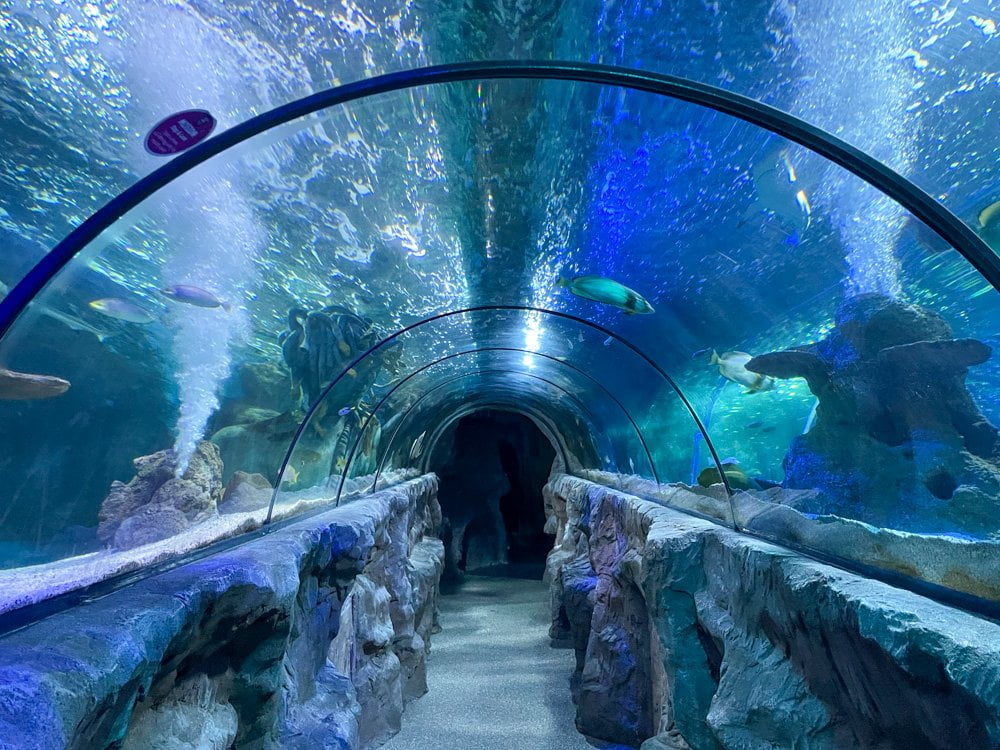
Humboldt Penguins
Humboldt Penguins are a South American species that breeds mainly in northern Chile. It is generally believed that all penguins live in cold places such as Antarctica or the South Pole. In reality, only a few types of penguin live as far south as the Humboldt Penguin.
Due to global warming and as a result of warm water currents, they are declining in numbers. Today, only about 10,000 Humboldt Penguins live free in the wild. Increased water temperature causes a reduction of the animals they feed on, in a devastating knock-on effect. Humboldt Penguins are purely carnivorous, eating only small crustaceans, squid and fish.
At the Great Yarmouth Aquarium, they live in a very scenic open space from which you can see the backdrop of the beach and pier. The great English weather is a perfect climate for them, and it is exciting to see them outside and not indoors in a glass tank like in other European aquariums.
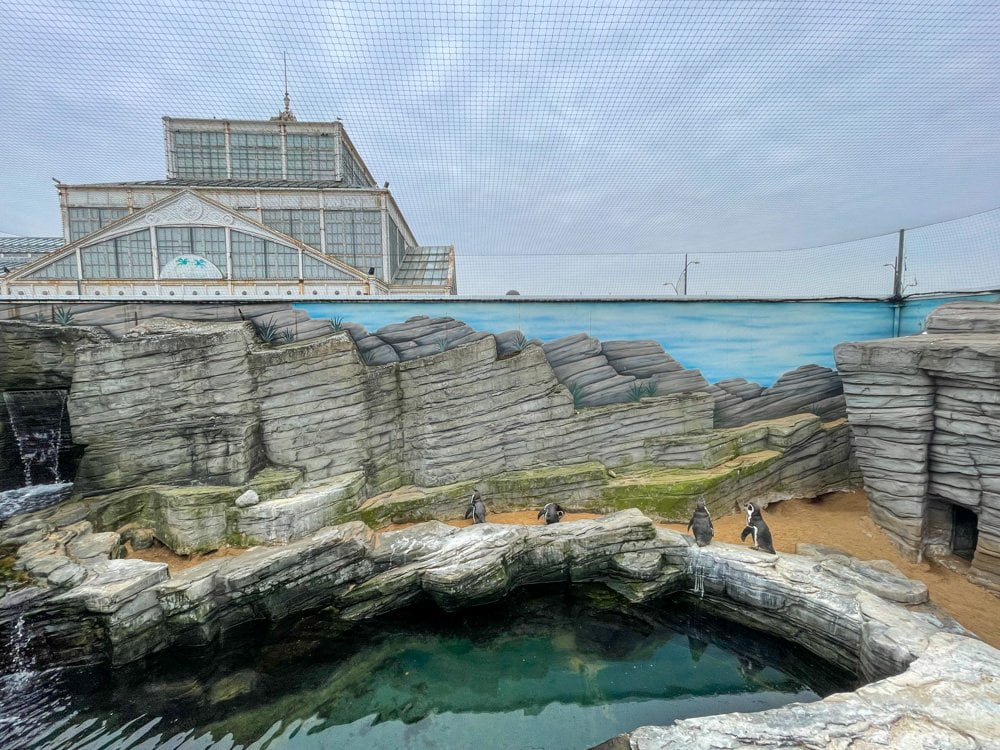
Rays
In the ‘Under the Ray-Dar’ area, you can have fun identifying the different species of rays. SEA LIFE Great Yarmouth, in its tanks, hosts both the cownose stingray and the wavy stingray. In recent years, the populations of wavy stingrays have declined dramatically because they were being fished wildly for their meat with trawls and set gillnets.
The stingrays seem incredibly peaceful but can defend themselves vigorously if they feel threatened. Stingrays can raise their tails to pierce a possible aggressor with their venomous quill. Once they have struck their predator, it takes a while for a new sting to grow back, so they only use this defensive tactic as a last resource.
Seahorses
Seahorses are fascinating and unique animals. Unlike any other fish, they have an upright physical structure. They use the prehensile tails to hook onto corals and seaweed to avoid being carried away by the current. Male seahorses ‘hatch’ their offspring in a pouch on their belly where a female can lay eggs. After a few weeks, the male seahorse ‘gives birth’ by releasing its young through a hole in its belly.
There are more than 40 species of seahorses distributed in oceans all over the world. Some live on coral reefs, others among mangrove roots and many in algae-rich seabeds. Two species of seahorses even live in the waters around Ireland and the UK.
The various species also differ in size. For example, pygmy seahorses are as tiny as a fingernail, while others are bigger than a hand. At SEA LIFE, seahorses live in a tank next to the stingray tank. They are small, and you may have to pay more attention to identify them among the algae.
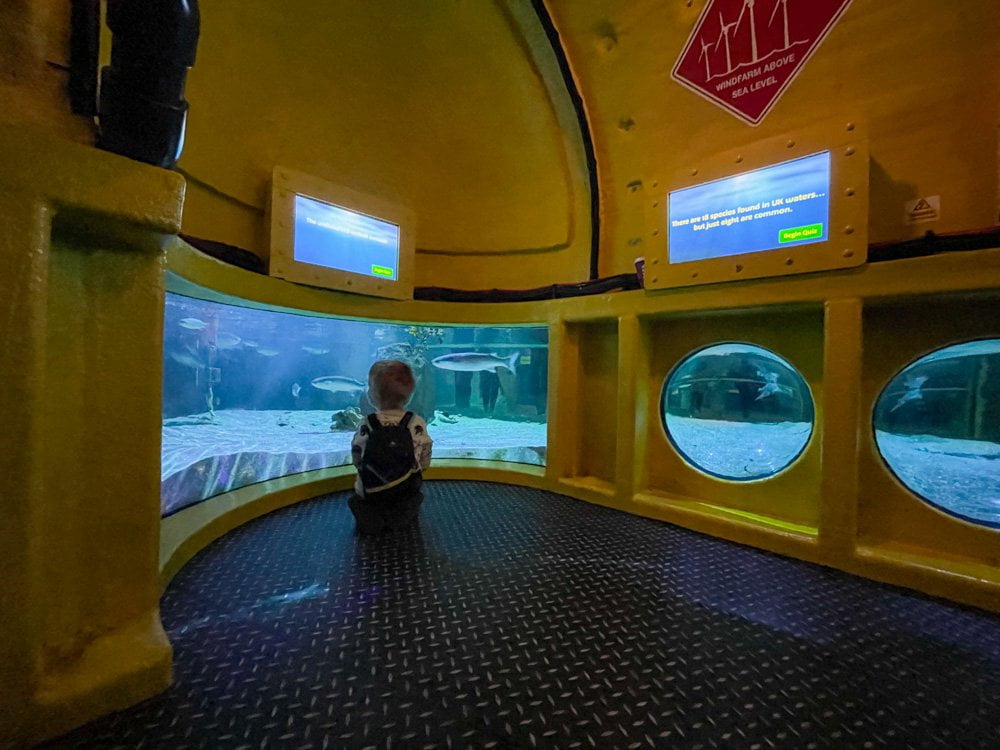
Sea turtles
SEA LIFE Great Yarmouth hosts many sea turtles. The most famous is Noah, an eleven-year-old vegetarian green turtle born in captivity in a turtle sanctuary in the Cayman Islands.
Turtles have existed for over 200 million years and shared our planet with the first dinosaurs. Rivers and oceans today are home to over 300 species of turtles, and there are seven species of sea turtles, some of which are endangered.
Some turtles are hunted for their shells but often end up trapped in fishing nets or plastic waste. SEA LIFE promotes awareness of pollution risks and explains how plastic bags are deadly for sea turtles. They often mistake them for jellyfish, their favourite food, and suffocate trying to eat them.
Turtles swim long distances because the places where they live and the beaches where they lay their eggs are so far away. The sex of baby turtles is determined by the temperature of the sand in which the eggs are buried. A higher temperature will give birth to female sea turtles and a lower one to males.
Red-eared turtles: not a pet
SEA LIFE Great Yarmouth hosts red-eared turtles donated by people who could no longer care for them, and there are so many of them that the aquarium has run out of space. Despite the widespread thinking, red-eared turtles sold in pet shops are not pets. Red-eared turtles need a lot of varied food, a heating lamp for sunbathing, a lot of water for swimming and can live for more than 40 years, becoming quite large.
Jellyfish
The ‘Jelly Invaders’ section is a modern aquarium classic, featuring jellyfish gracefully dancing under multicoloured lights. A similar display had caught my eye at the Acquario di Genova, offering a unique perspective on these fascinating creatures despite the occasional inconvenience of encountering them in the sea.
Jellyfish, one of the oldest animal species, are believed to have appeared around 500 million years ago, boasting over 350 species. SEA LIFE Great Yarmouth showcases Moon Jellyfish, a typical UK species, allowing visitors to explore their life cycle. These jellyfish can thrive in temperatures ranging from 6 to 31 degrees Celsius and possess mildly venomous tentacles for prey capture.
Must-do activities at SEA LIFE Great Yarmouth
SEA LIFE Great Yarmouth offers a range of unique experiences like keepers talking and feeding fish. You can also explore several interactive zones to learn more about marine animals. In ‘The Rockpool Explorer Experience’, you’ll discover how fish have adapted to living in the shallow pools of the British coast. ‘The Tropics habitat’ is an incredible tunnel with the theme of the Lost City of Atlantis. In the ‘Under the Ray-Dar’ area, you can meet stingrays aboard a research submarine. SEA LIFE Great Yarmouth has many more must-see exhibits, which you can explore by continuing to read.
Rockpool Explorer Experience
The rock pools on the British coastline formed when the water remained when the tide went out. They are incredible micro-habitats home to many different creatures able to adapt to the temperatures and waves crashing over them. In the ‘Rockpool Explorer Experience’ area, you can see up close and touch starfish, an animal that lives in all the world’s oceans. There are over 2000 known species of starfish. Most have five arms, but some species can have up to 24.
Starfish have no brain, heart or blood. They only have a stomach, which they can partially spill out of their bodies to digest food larger than their mouths and then suck it out at the end. My three-year-old son loved this disgusting detail. When predators attack starfish, they can tear off an arm and regrow it later. Fortunately, here, you can only stroke them gently under the supervision of SEA LIFE keepers.
Other inhabitants of the rocky habitat are sea anemones and crabs. Despite looking plants, sea anemones are animals, closely related to jellyfish and corals. Sea anemones also have no brain, heart or blood, but this does not prevent them from being great predators thanks to their stinging tentacles. Those in the ‘Rockpool Explorer Experience’ tanks are safe to touch as their stings are too weak to be felt.
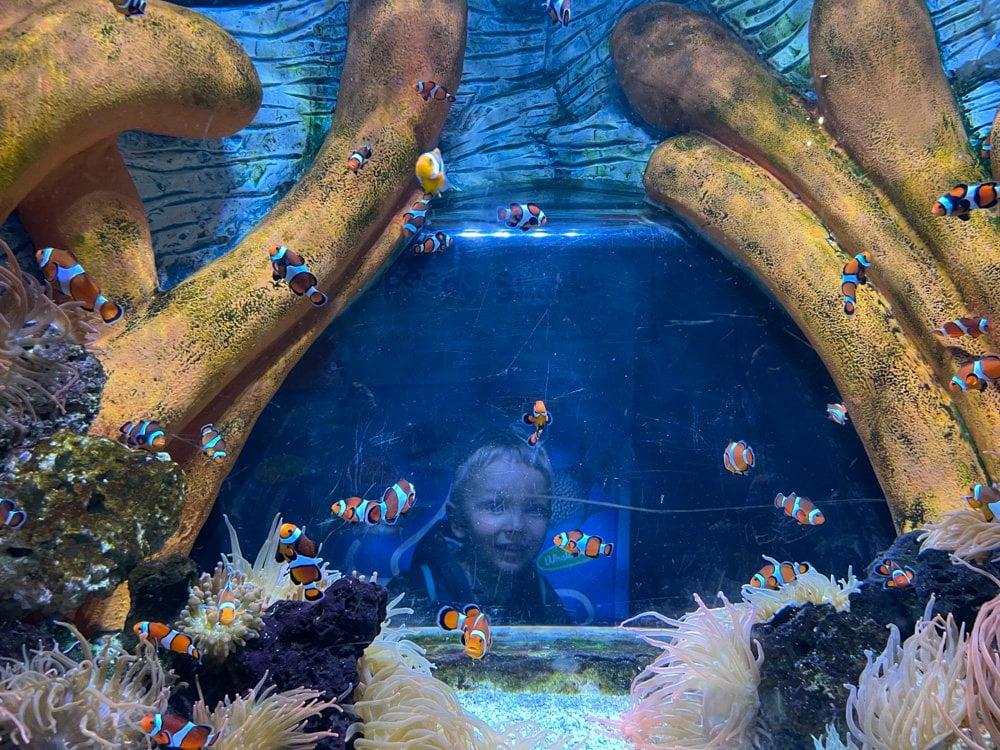
Marine conservation activities
Like all modern aquariums, SEA LIFE Great Yarmouth contributes to protecting the marine environment and does so through SEA LIFE Trust, the group’s charity.
SEA LIFE Trust created new marine protected areas, contributed to reducing marine litter with beach cleaning events, and initiated many animal welfare activities. Today, SEA LIFE Trust manages two protected areas:
- the Beluga Whale Sanctuary in Iceland
- the Cornish Sea Sanctuary in the UK
The Beluga Whale Sanctuary is off the south coast of Iceland and is the first of its kind in the world, providing a new home for formerly captive animals. On the other hand, the Cornish Seal Sanctuary cares for sick and injured seal pups and then releases them back into their natural environment.
Visiting aquariums: YES or NO
When visiting attractions with captive animals, I always ask myself whether it is ethical. Travelling with my son made me realise how important it is to spread awareness and respect for animals. First, aquariums do tremendous work in animal welfare and protection. Without modern zoos and aquariums, there would not be so many endangered animal protection programmes.
Fish are primarily born in captivity from breeding programmes for endangered species, but aquariums also care for animals that cannot live in freedom. These facilities host injured animals, and the healed ones that can survive in the wild are returned to their environment of origin while the others become guests of the facility.
For adults and children, meeting animals in person is an easy way to learn about nature and spread respect for the natural words. Aquarium and zoo keepers can answer children’s curious questions while conveying concern for animals.
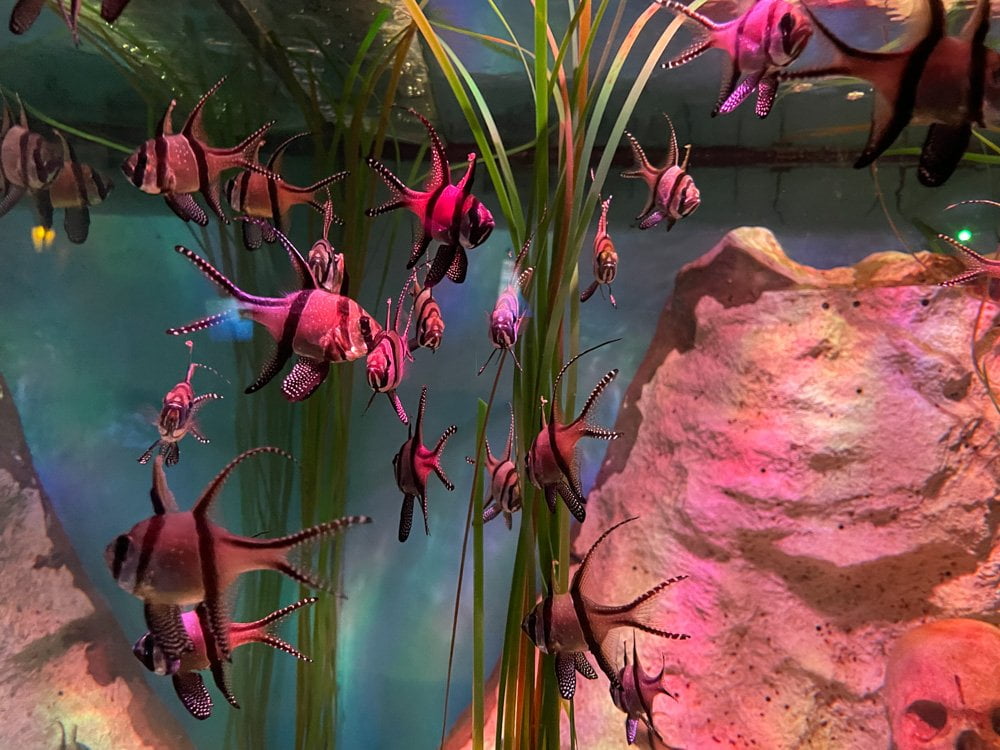
Practical information for visiting SEA LIFE Great Yarmouth
The SEA LIFE aquarium is a must-see destination on your holiday in Great Yarmouth, especially if you are travelling with children. It is precisely the educational and nature-friendly attraction I look for when travelling with my son.
For the best experience, I recommend visiting the aquarium early in the morning as it gets crowded quickly. By entering early, you can move better between the tanks and appreciate the layout. I also recommend buying the aquarium guide to read interesting facts and information about the animals in the aquarium. You can find it at the ticket office.
Why visit SEA LIFE Great Yarmouth with children
For children, SEA LIFE is a fun attraction. There are plenty of fish to discover and an area with a submarine where you can observe the animals from a porthole. The Ocean Tunnel is incredibly scenic, especially when sharks or other large fish pass.
There is also an area for the little ones to play and colour with markers and drawings of Peppa Pig, the aquarium mascot. I wouldn’t say I like this character, but my son had a lot of fun colouring and cutting out crustacean and mermaid costumes for Peppa Pig.
How much does it cost to visit SEA LIFE Great Yarmouth
Unfortunately, SEA LIFE tickets are not cheap. Standard Tickets start at £18/€20 when purchased online and provide entry to SEA LIFE Great Yarmouth in a time slot of 10 minutes, which can be rescheduled free of charge up to 24 hours in advance. You can choose more flexible but expensive tickets if you prefer not to have such tight entry times.
Children up to three years old get in free at SEA LIFE Great Yarmouth. Older kids have just a small discount on the Standart Ticket. Therefore, a visit to the aquarium will use up a large part of your daily budget, but it will be a truly educational and memorable experience.
Since it is a top-rated attraction, I recommend booking your ticket in advance, especially during bank holidays or school breaks. Check the availability on the calendar and secure your admission now.
Where is the SEA LIFE Great Yarmouth Aquarium
The SEA LIFE aquarium is on the Great Yarmouth waterfront and is easily accessible on foot or by tourist train from the city centre. If you are travelling by car, there are several car parks along Marine Parade, all of which you must pay for.
SEA LIFE Great Yarmouth
Marine Parade
Great Yarmouth NR30 3AH
Where to stay in Great Yarmouth
In Great Yarmouth, you can choose to stay in one of the charming waterfront hotels, many of which date back to the town’s Victorian seaside heyday. My favourites include the elegant Ocean Hotel, which offers the added convenience of free parking, and the cosy, family-run B&B The Weatherdene, where I felt right at home when I stayed with my son.
In the comments, share your experience if you were familiar with the Great Yarmouth Aquarium or have visited other SEA LIFE facilities worldwide.
